
Earlier this week, the New York Times published an interesting article arguing that America’s young will be disproportionately affected by the fall out of the US debt ceiling debacle:
Eventually this shutdown crisis will end. And eventually the two parties will make another stab at a deal on taxes, investments and entitlements. But there’s one outcome from such negotiations that I can absolutely guarantee: Seniors, Wall Street and unions will all have their say and their interests protected…
Short of an economic meltdown, there is only one thing that might produce meaningful change: a mass movement for tax, spending and entitlement reform led by the cohort that is the least organized but will be the most affected if we don’t think long term — today’s young people.
Whether they realize it or not, they’re the ones who will really get hit by all the cans we’re kicking down the road. After we baby boomers get done retiring — at a rate of 7,000 to 11,000 a day — if current taxes and entitlement promises are not reformed, the cupboard will be largely bare for today’s Facebook generation…
Oddly enough, leading the fight for America’s young is Stanley Drukenmiller, a legendary baby boomer investor and founder of Duquesne Capital, who is urging America’s “future seniors” to start a movement to protect their interests.
Earlier this year, Drukenmiller appeared on Bloomberg whereby he warned that the ageing of the population and transfer payments to the elderly (paid for by a declining tax base) threaten to permanently constrain the US economy and create an inter-generational war.
Now Drukenmiller has taken measures one step further, giving speaking tours to crowds of students at Berkeley, Stanford, Brown, U.S.C., Bowdoin, Notre Dame and NYU, urging them to take action against intergenerational unfairness:
“My generation — we brought down the president in the ’60s because we didn’t want to go into the war against Vietnam,” Druckenmiller told an overflow crowd at Notre Dame last week. “People say young people don’t vote; young people don’t care. I’m hoping after tonight, you will care. There is a clear danger to you and your children.”
Whenever Druckenmiller (a friend) is challenged by seniors, who also come to his talks, that he is trying to start an intergenerational war, he has a standard reply: “No, that war already happened, and the kids lost. We’re just trying to recover some scraps for them.”
With graph after graph, [Drukenmiller] show[s] how government spending, investments, entitlements and poverty alleviation have overwhelmingly benefited the elderly since the 1960s and how the situation will only get worse as our over-65 population soars 100 percent between now and 2050, while the working population that will have to support them — ages 18 to 64 — will grow by 17 percent. This imbalance will lead to a huge burden on the young and, without greater growth, necessitate cutting the very government investments in infrastructure, Head Start, and medical and technology research that help the poorest and also create the jobs of the future…
It seems deeply offensive to me that we will be asking these poor children from Harlem to subsidize a generation that is, by and large, more well-off than they are, and then leave them deeply indebted in an America that had eaten the seed corn of the next generation.”
Among the measures recommended by Drukenmiller include: increasing taxes on capital gains, dividends and carried interest – which currently overwhelmingly benefit the wealthy and retired – so that they more closely match taxes on wage and salary earnings; means testing health care and social secuity so that they are needs-based not aged-based; and cutting corporate taxes to zero, so that companies will have incentives to hire more workers.
It’s worth pointing out that Australia’s demographic profile is very similar to the US.
The below chart compares the dependency ratio – i.e. the ratio of the non-working population, both children (< 20 years old) and the elderly (> 65 years old), to the working aged population – in Australia versus the US. As you can see, the dependency ratios fell steadily in the decades to 2010. However, in the decades ahead, both countries’ dependency ratios are projected by the United Nations to rise steadily as the baby boomers retire and their populations age:

It’s a similar story when the number of working-aged people (i.e. those aged between 20 and 65) is compared against the elderly (i.e. aged over 65). The ratio of working aged population to the elderly is projected by the United Nations to nearly halve by 2035 (see next chart).

Similar demographic constraints are coming to our shores as well.

